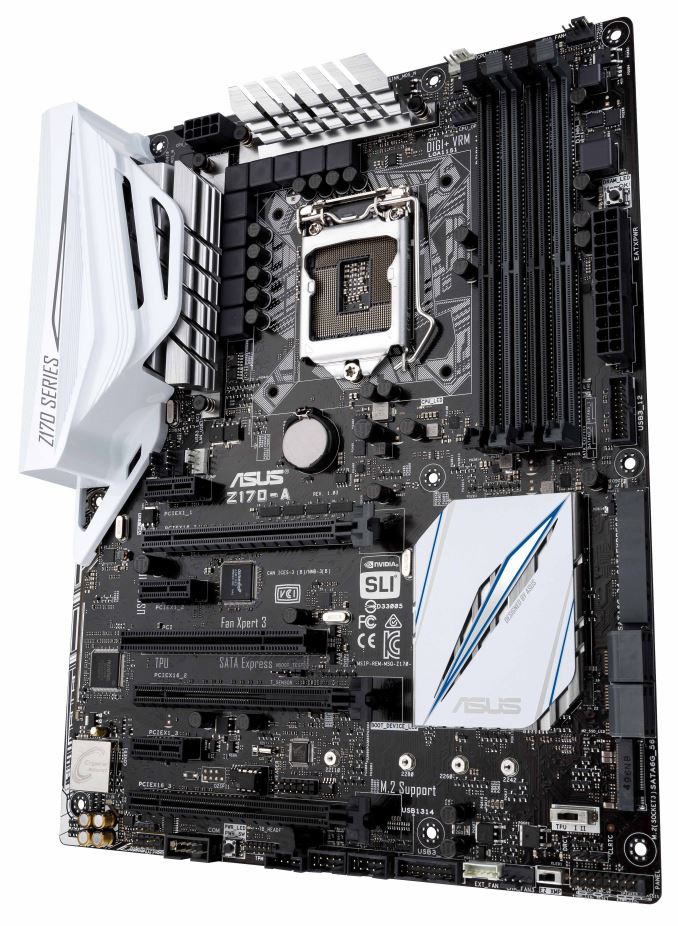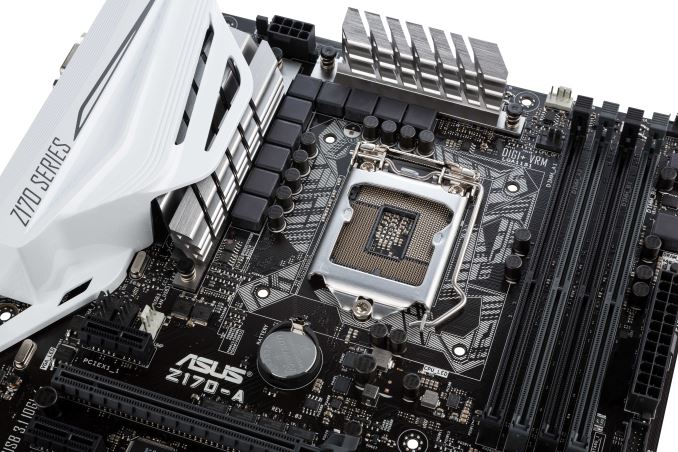The ASUS Z170-A Motherboard Review: The $165 Focal Point
by Ian Cutress on October 20, 2015 2:00 PM EST- Posted in
- Motherboards
- Asus
- ATX
- Skylake
- Z170
ASUS Z170-A Conclusion
At the start of this review I discussed the nostalgia elements of the industry. There is a fondness to reminisce about former glory days - personally this means setting up my Commodore 64 with a CRT and playing Mayhem in Monsterland, the Atari ST, getting to grips with DOS before moving up through gaming, building a system from an Athlon and seeing my X1900XT slowly degrade from too many overclocks before pushing my 2600K to 5.3 GHz for an overclocking league. The question is - what motherboards over time invoke these emotions, and what is going to be fondly remembered this generation?
From yesteryear there seems to be a fondness for DFI, a now defunct motherboard manufacturer, who made some hardcore products in garish color schemes. PC builders my age might remember those dual AGP/PCIe boards as the march to SATA occurred. Then who can forget Intel's dual CPU Skulltrail platform, or the EVGA X58 Classified that stormed the extreme overclocking charts? Will there be anything here today that is remembered in a similar light? What do all these boards have in common?
Perhaps a nod to nostalgia in this segment is not a consideration - no motherboard manufacturer goes out of their way to design a generational icon, just because it doesn't make financial sense in this industry. They have to attack high volume, high margin markets and provide better user experience in their market than the competition. Very few manufacturers try something off-the-wall because the industry requires a clinical approach. It makes for a very high base standard in a way that is different from how Apple designs smartphones - while aesthetics have become more important (especially in gaming builds) over the last two generations, the point of differentiation between manufactures hides in the build components and quality (which for most purposes has a passive effect) or the actual functionality (active effect), software and box contents.
When it comes to what we call the 'channel' line of motherboards, there is no impetus to go bold. The motherboard has to work, has to have the features, and not look like a brown or green potato. In the past, this felt like a high barrier that some failed to hit, but in 2015 it is now the base on which all motherboards must spring. From our tour at ASUS' headquarters and other motherboard HQs over the years, it is clear that motherboard manufacturers are recognizing that good build quality, value and function helps define the core of their brand.
This brings us back to the actual topic of this review, the ASUS Z170-A. As a functional tool, it aims to have at least one of everything for the modern chipset except Thunderbolt, so this means an M.2 slot running at PCIe 3.0 x4, USB 3.1-A at 10 Gbps, USB 3.1-C at 10 Gbps, Intel I219-V networking and SATAe. In the background is a Pro-Clock IC to extend the Base clock range, a TPU to improve automatic overclock control, an Auto-XMP switch to enable a memory extreme profile and a T-Topology memory design usually reserved for the high end platforms.
The Z170-A has a clean look which some will appreciate, as well as audio-side LEDs that can be enabled. Functionally, this board was used for this review and some of our other Skylake testing with few issues. Despite the fact that multicore turbo is not enabled by default, the latest BIOSes enable FCLK control and the automatic overclock engine gives 4.8 GHz without any issues. The Z170-A also scores well in our system benchmarks, particularly DPC Latency and USB speed when Turbo mode is enabled in AI Suite. The BIOS and software receive their respective updates for the new generation as well.
There are a number of motherboards floating in this $160-$170 price bracket, giving the ASUS Z170-A a good amount of competition. The main differences will be in exact implementation - another board might use an ALC1150/ALC898 audio codec over the ALC892, or dual M.2, or dual networking, or gaming branded technology, or come with a font USB 3.1 panel, often in exchange for a different feature elsewhere. From our testing, the ASUS Z170-A might never be a nostalgic icon, and there are a few things still to work on (namely update software) but it is well worth looking into for the price point given the feature-set, BIOS and software tools.
| ASUS Z170-A | |
| Warranty Period | 3 Years |
| Product Page | Link |
| Price | Amazon US Newegg |
| Size | ATX |
| CPU Interface | LGA1151 |
| Chipset | Intel Z170 |
| Memory Slots (DDR4) | Four DDR4, Supporting 64GB, Dual Channel, Up to 3466 MHz |
| Memory Slots (DDR3L) | None |
| Video Outputs | HDMI DisplayPort DVI-D D-Sub |
| Network Connectivity | Intel I219-V |
| Onboard Audio | Realtek ALC892 |
| PCIe Slots for Graphics (from CPU) | 2 x PCIe 3.0 (x16, x8/x8) |
| PCIe Slots for Other (from PCH) | 1 x PCIe 3.0 x4 3 x PCIe 3.0 x1 1 x PCI |
| Onboard SATA | 6 x SATA 6 Gbps, RAID 0/1/5/10 |
| Onboard SATA Express | One |
| Onboard M.2 | One, 2242 to 22110, SATA and PCIe 3.0 x4 modes, AHCI and NVMe |
| Onboard U.2 | None |
| USB 3.1 | 1 x Type-A 1 x Type-C ASMedia ASM1142 Controller |
| USB 3.0 | 2 x Rear Panel 4 via headers |
| USB 2.0 | 2 x Rear Panel 4 via headers |
| Power Connectors | 1 x 24-pin ATX 1 x 8-pin CPU |
| Fan Headers | 1 x CPU (4-pin) 1 x CPU_OPT (4-pin) 4 x CHA/SYS (4-pin) |
| IO Panel | 1 x Combination PS/2 2 x USB 2.0 2 x USB 3.0 1 x USB 3.1 Type-A 1 x USB 3.1 Type-C 1 x Network RJ-45 (Intel I219-V) HDMI DVI-D DisplayPort D-Sub Audio Jacks |
| Other Features | COM Header Thunderbolt Header EZ XMP Switch DirectKey Header MemOK! Button TPU Switch 5-pin FAN_EXT Header TPM Connector Power Button Front Audio Header Front Panel Header USB BIOS Flashback Header |












29 Comments
View All Comments
ciderrules - Tuesday, October 20, 2015 - link
This is the MB I bought for my new Skylake system. Always had good luck with ASUS in the past, and it's performed well so far with no issues noted (crosses fingers).Only complaint (and it's not really a fault) is it feels a little "flimsy/flexible", as if the board itself wasn't as thick as it could be. Couple with a Dark Rock Pro 3 heatsink in a tower case, and suddenly there's a lot of stress on the MB causing it to flex from the weight of the heatsink. Remedied this by making a small custom bracket from the sink to my case to take some of the weight off.
blppt - Tuesday, October 20, 2015 - link
Sadly, that may be a trend for ASUS's lower end stuff---the Z97-E I picked up a while back had a flimsy-feeling PCB, and slightly loose SATA connector housings. Havent had a single problem with it yet, but that cheap feeling is not exactly a great first impression.By contrast, the similarly-priced Z97X-Gaming 7 from Gigabyte I bought for my other Intel box felt much sturdier.
Samus - Wednesday, October 21, 2015 - link
It isn't a trend of Asus. This is industry-wide. There is no longer a need for 10 layer PCB's. With so much integrated into the CPU and everything being such low power, most reference designs are only 4-6 layers thick anymore. All of these first-out products are heavily based on, if not nearly identical too, the chipset reference. In a few months we may start seeing more "creative" boards of higher caliber.Billie Boyd - Friday, November 27, 2015 - link
There are a couple of good MB that I can recommend and some of this are seen on http://www.consumerrunner.com/top-10-best-desktops... too.Kutark - Sunday, November 1, 2015 - link
I used to be a dyed in the wool Asus guy, until around 2007 or so. The last few builds I did for myself and for friends from around 2005-2007, in 6 systems we had 4 Asus boards go bad within 1-6 months of use. By then I switched to Gigabyte and in over 13 MB's I've only had an issue with 1 (the IDE controller started going out), which was RMA'd and replaced.BillyONeal - Tuesday, October 20, 2015 - link
Ooh. I like the "Other AnandTech Reviews for Intel’s 6th Generation CPUs" inset.Oogle - Tuesday, October 20, 2015 - link
FYI, as of this post, the 14-1 pin TPM connector has no part that can fit it. So in order to do bitlocker on your system drive, you will need a password or usb drive to access the drive on boot.PVG - Tuesday, October 20, 2015 - link
My board of reference in this price bracket is the ASRock Z170 Extreme4. It offers a bit more for the same money.jabber - Wednesday, October 21, 2015 - link
Just wish some of them would drop the VGA/DVI sockets. Hate having legacy stuff I'll never use, bad enough with built in audio.Gigaplex - Friday, November 6, 2015 - link
I agree with VGA, but I still use DVI. I find HDMI a pain to use, as everything keeps trying to be too clever, assuming some percentage of overscan or understand, using the wrong pixel format (YUV vs RGB) etc. My monitors aren't new enough for DisplayPort, so it's DVI for me.